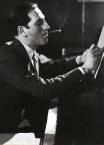The 20th CENTURY 1900 - 2000Along with all the developments in popular music of 'Jazz' and all its styles, 'Folk music' and 'Rock and Pop', the more formal styles of music of the 20th century became a period of ‘isms’ and ‘alities’. There is a long and extremely diverse list of these!
Some composers such as Debussy and Ravel set about exploring modality and the pentatonic scale; others like Berg and Schoenberg stretched the whole concept of tonality to breaking point. Yet there was still a great deal of tonal, neo-romantic music being written - examples being Kabalevsky, Shostakovich and Elgar.
2oth century structuresWhile many composers continued to use traditional forms, others have discarded them. Instead of building sections out of phrases or motives, composers now use what they call “sound events.”
A sound event might be an artificially manipulated combination of textures, timbres, different pitches... not merely tones but also noises; in fact, sounds of all kinds. An important principle of organization has been serialism, as in the music of the French composer Olivier Messiaen and the German Karlheinz Stockhausen. There are also works, such as those of the American John Cage, in which the form is not predetermined by the composer but left to chance. These statements apply particularly to electronic music.
The musique concrète developed about 1948 by Pierre Schaeffer and his associates, was an experimental technique using recorded sounds as raw material: |
2oth century composers
2oth century instrumentsBy the 20th century the piano was a very sophisticated instrument. Its mechanism became ever more miraculously engineered, and composers exploited in full the increased dynamic possibilities of the instrument.
The Impressionist composer Debussy used the instrument to great effect to produce music reflecting his use of the whole tone and pentatonic scales. Listen to this excerpt from his piano prelude, ‘Voiles’, in which the whole tone scale is clearly heard throughout the excerpt as the music is built over a pedal creating a rather mystical, dreamy effect: Other composers altered the workings of the instrument entirely, or attached amplification equipment or other objects to it, to transform the sound entirely. So-called prepared pianos feature in the works of Villa Lobos and John Cage.
The invention of the synthesiser in the 1960s added a whole new range of sounds at the fingertips of any competent keyboardist. MIDI sequencers were used increasingly from 1990s onwards. |



